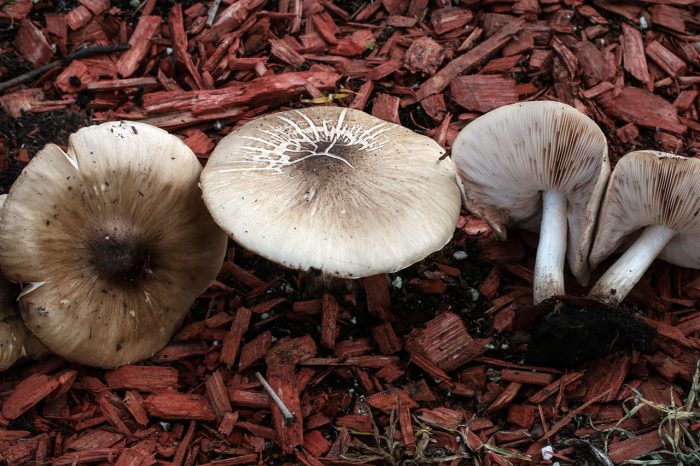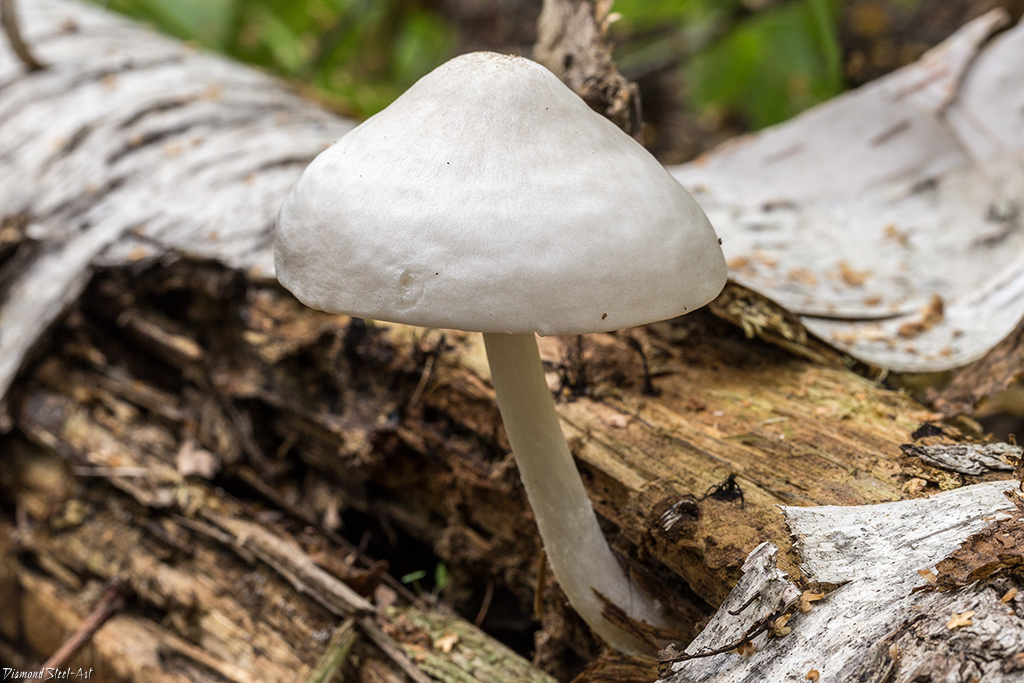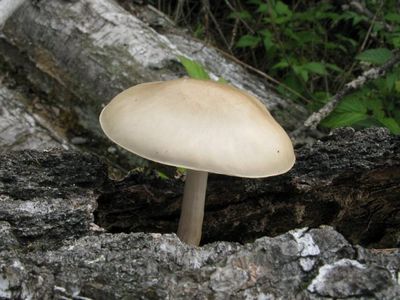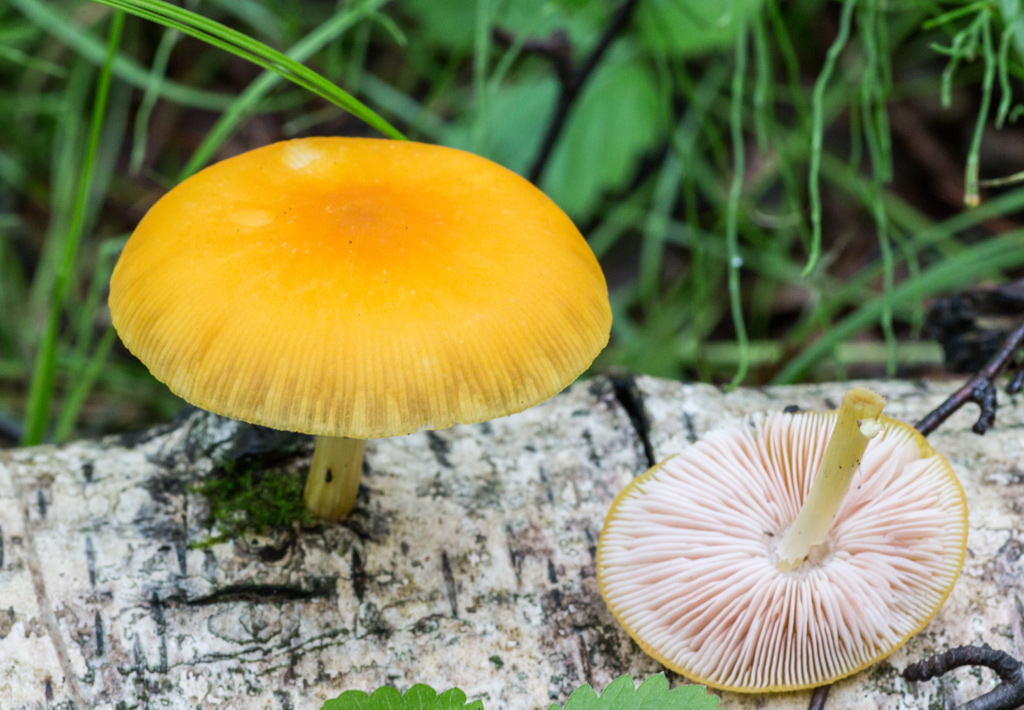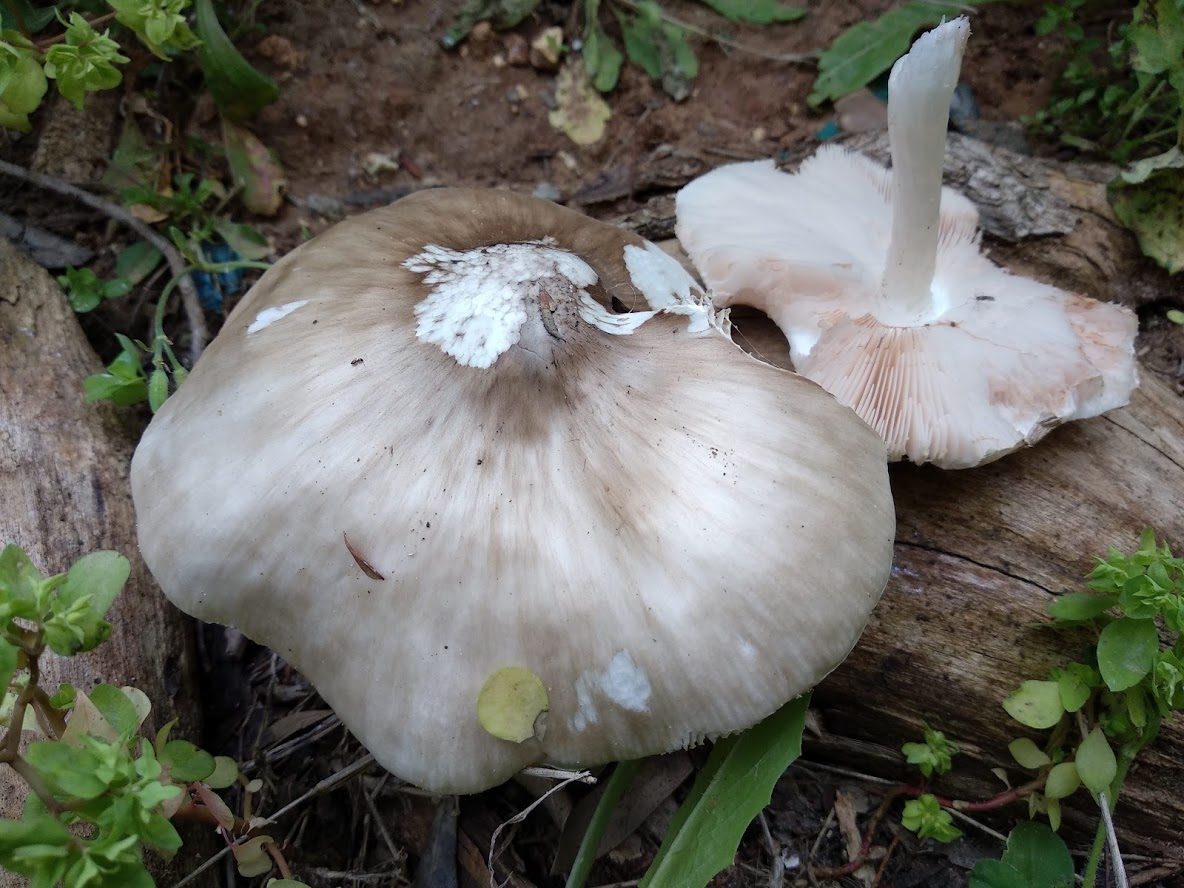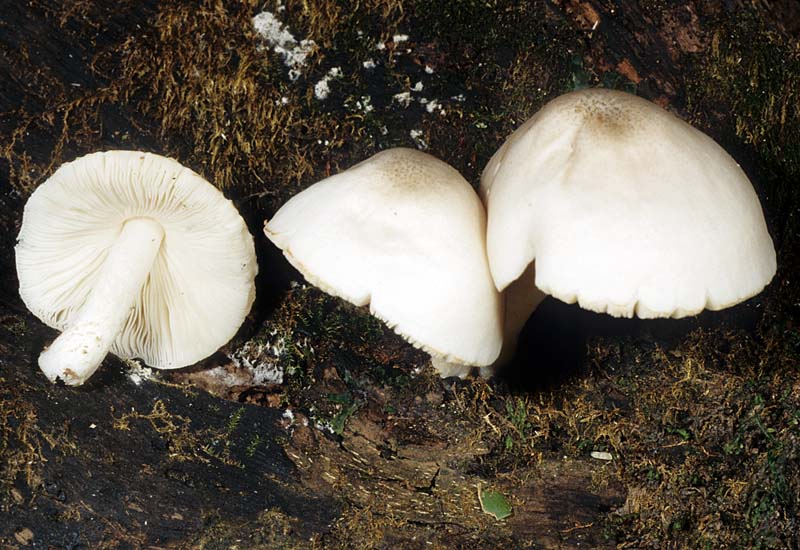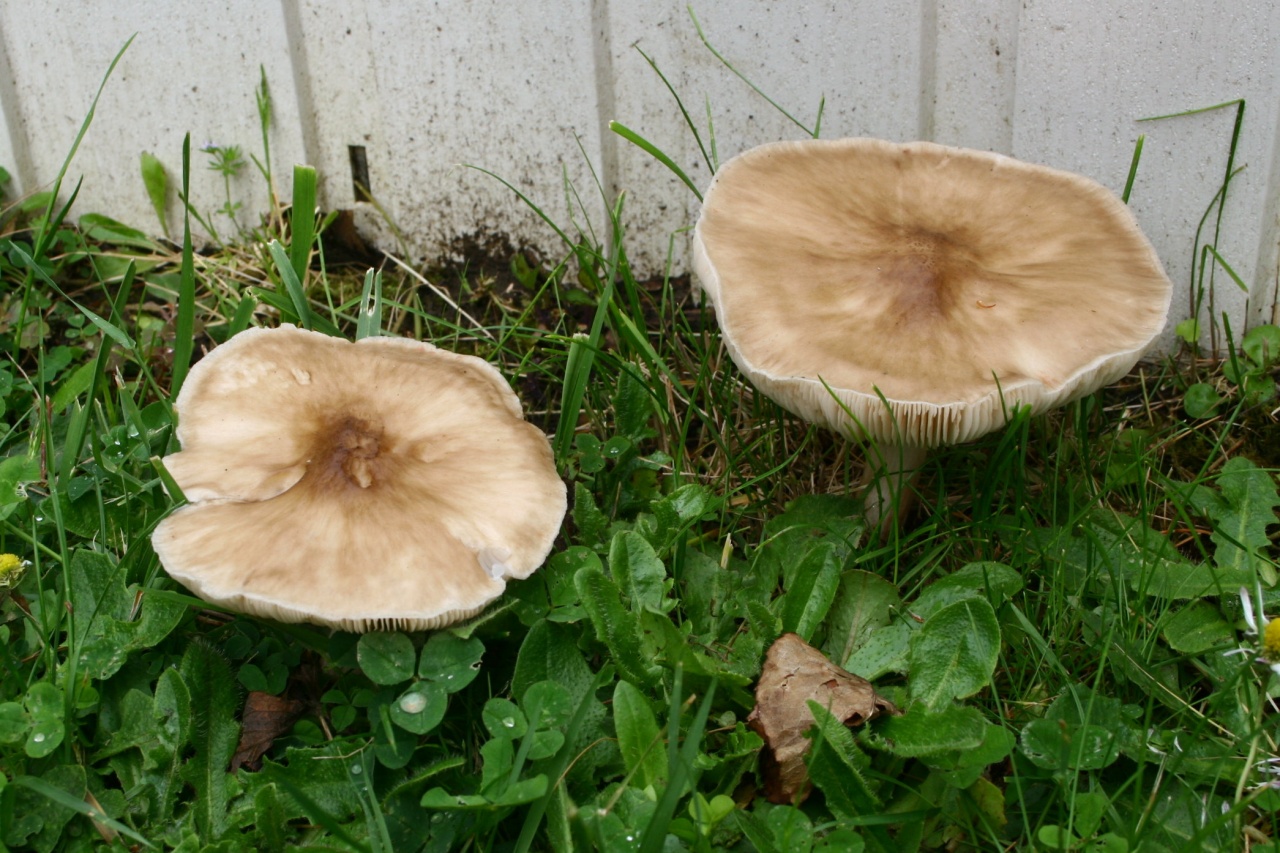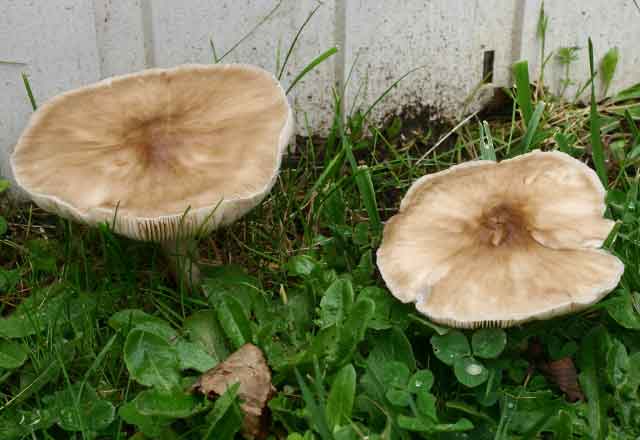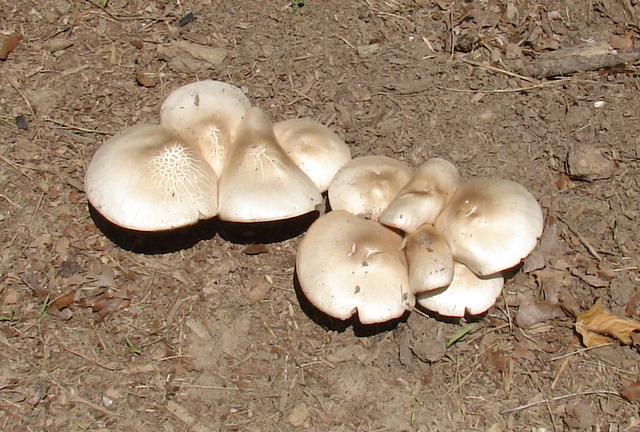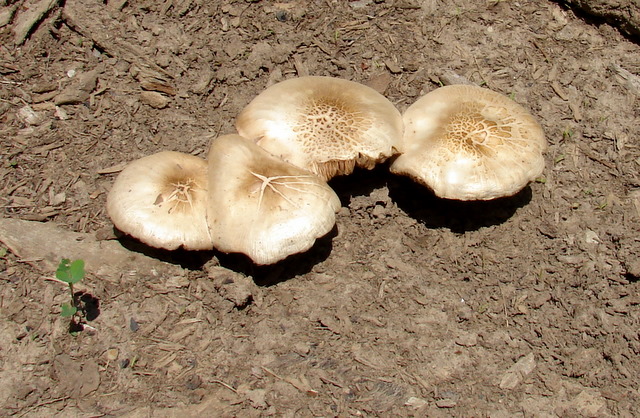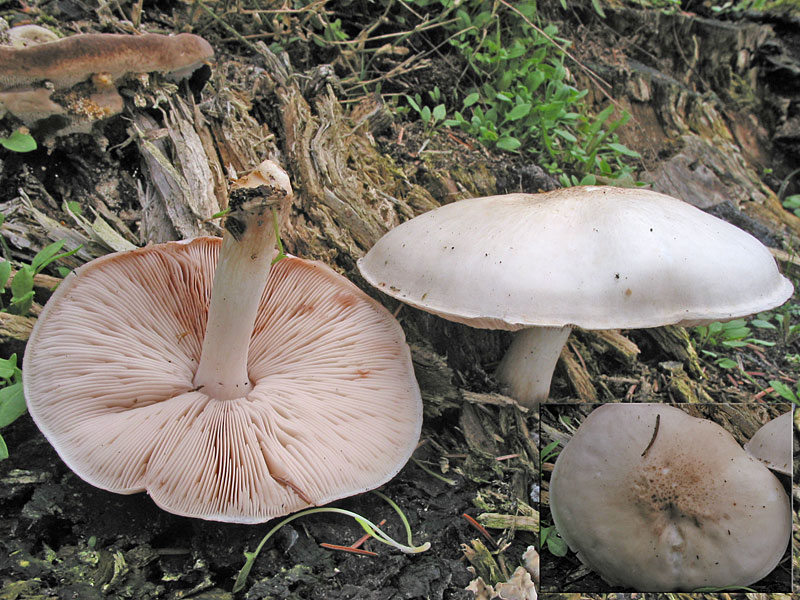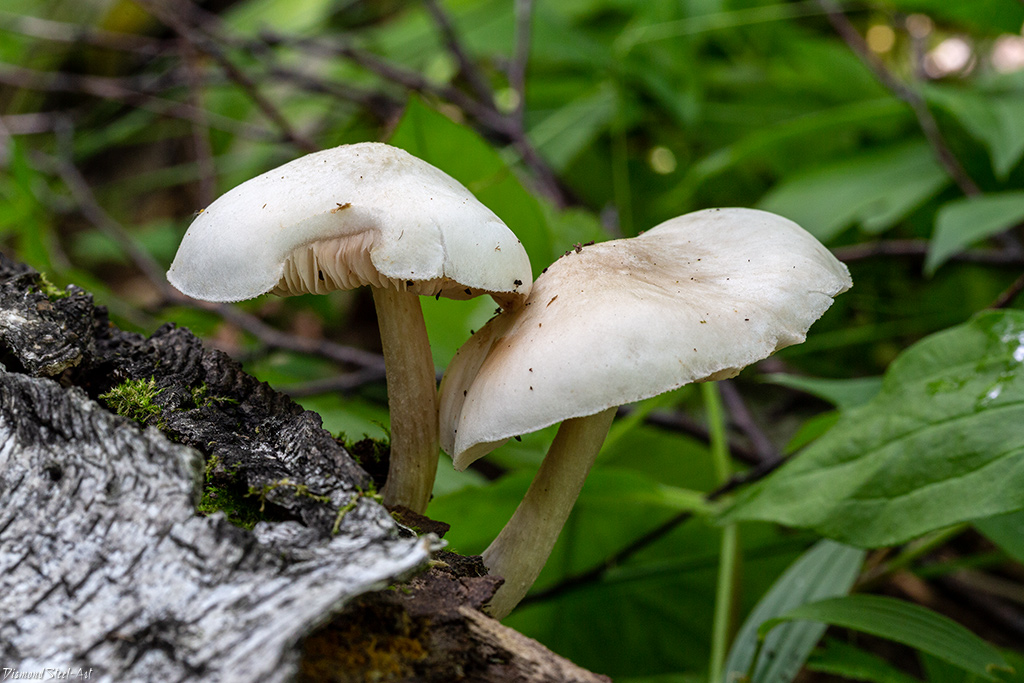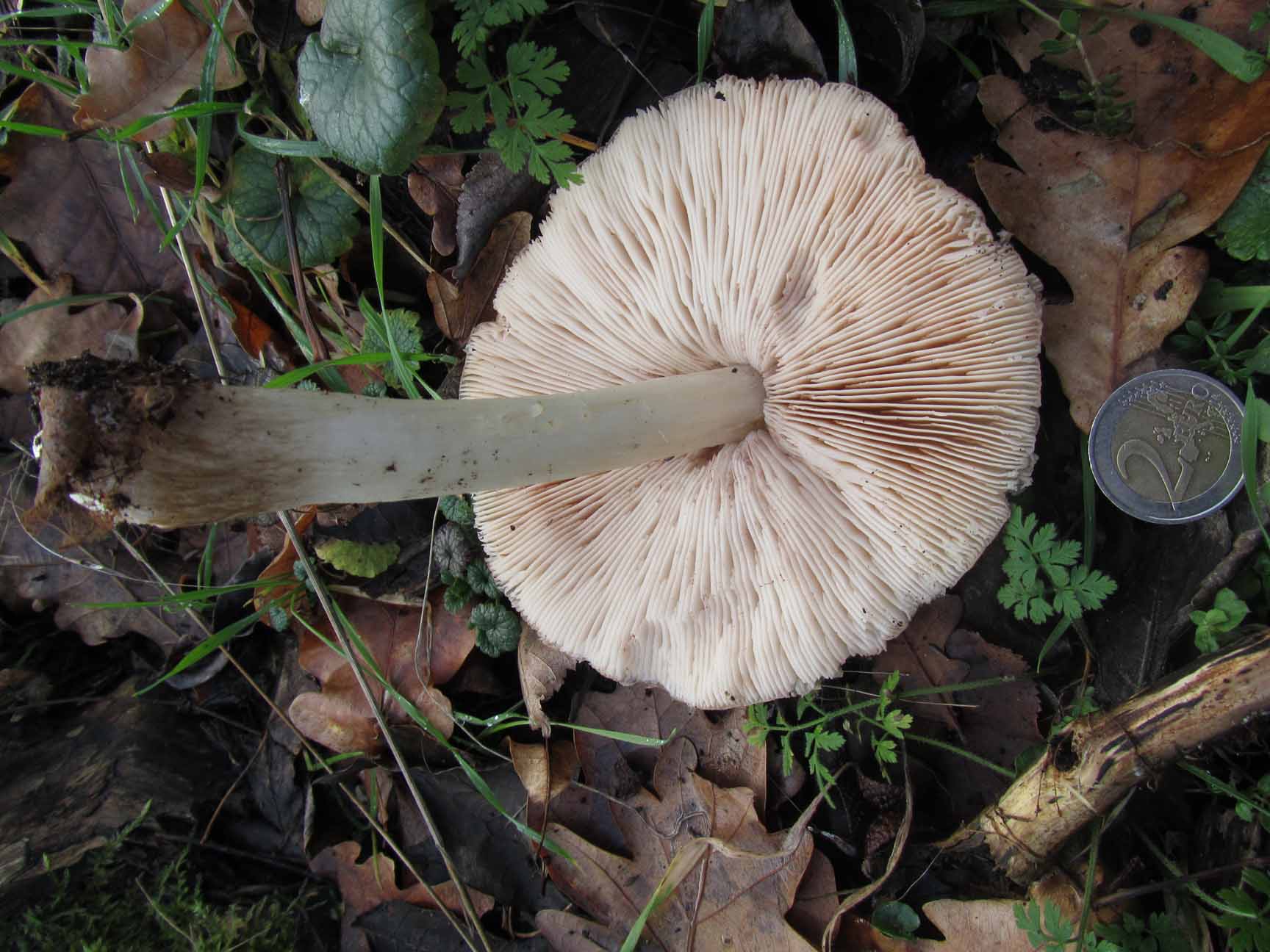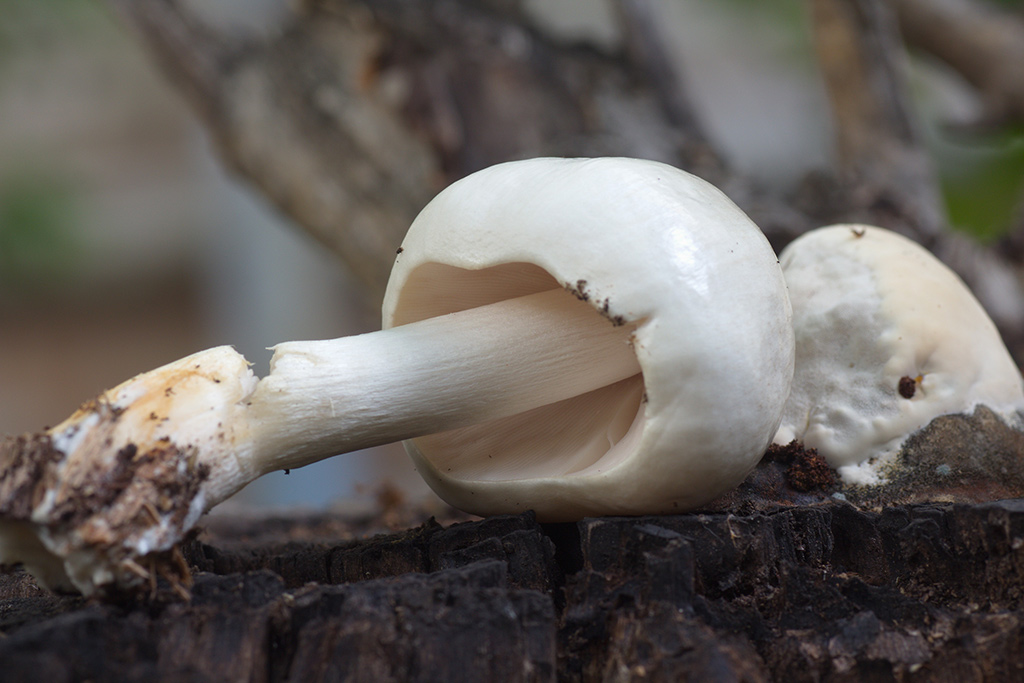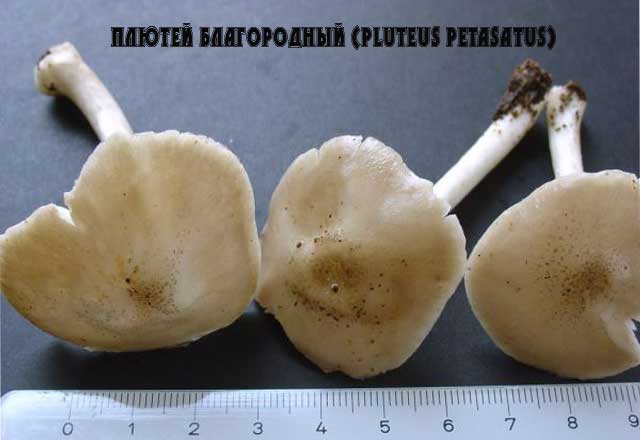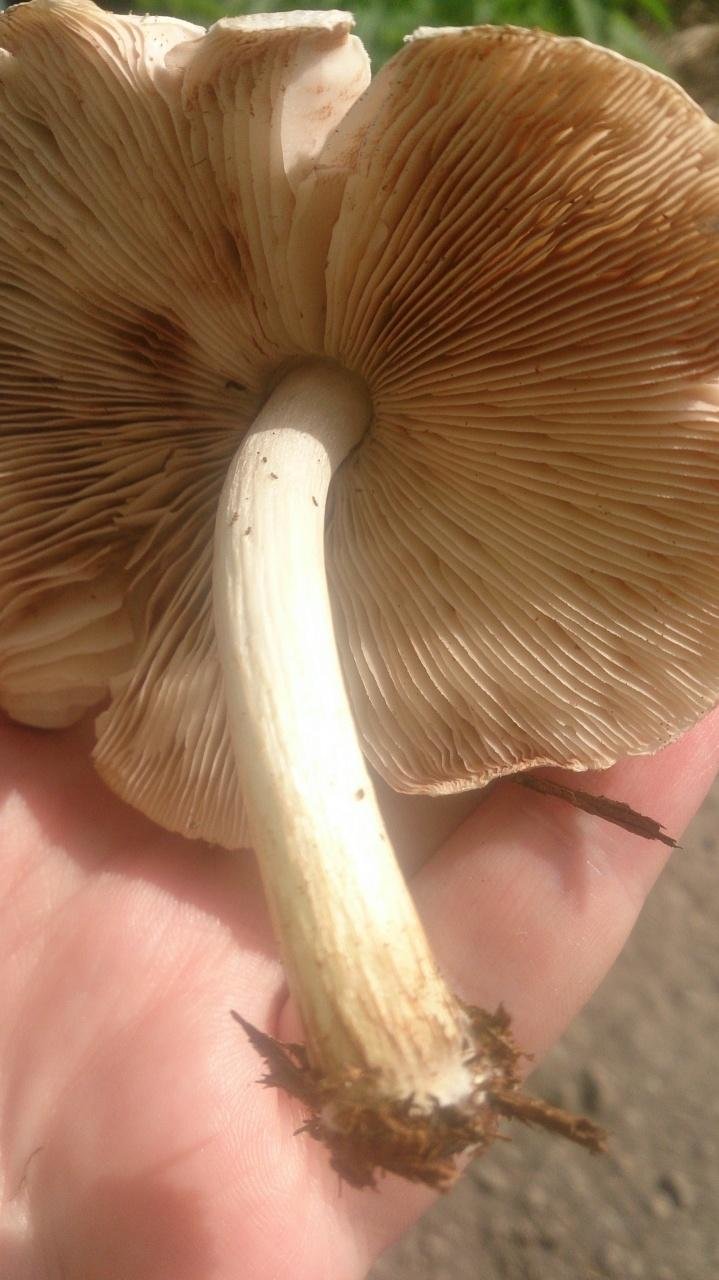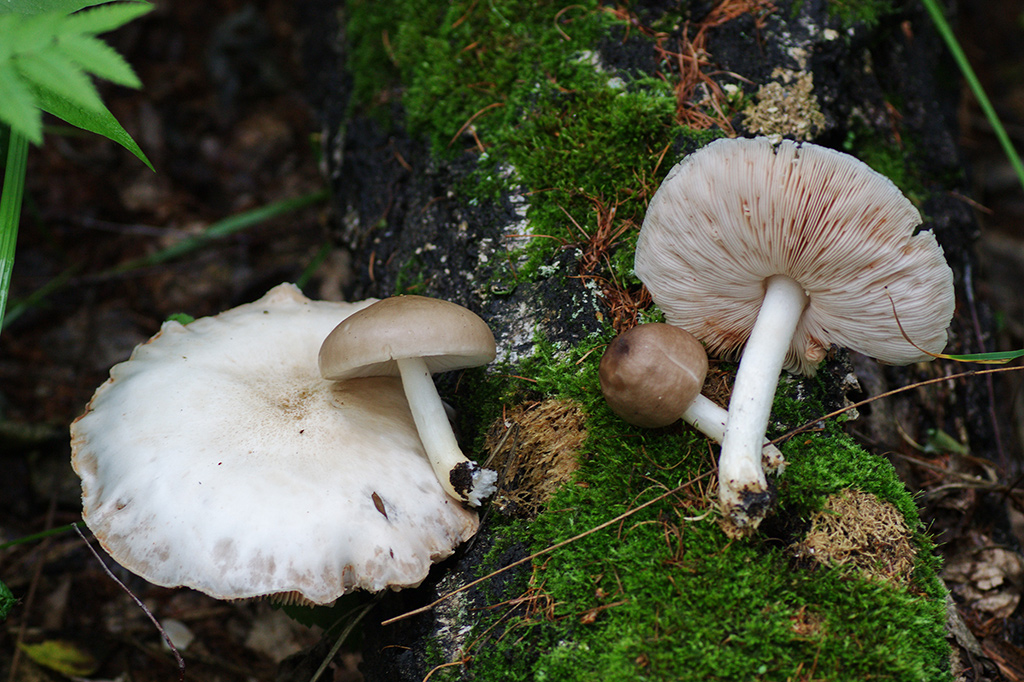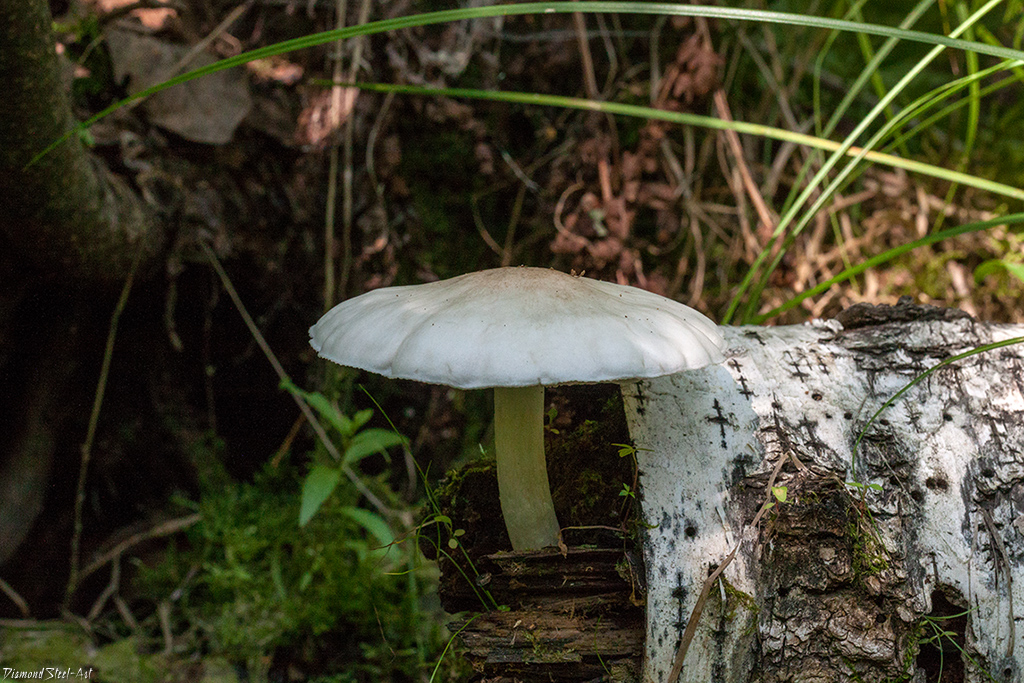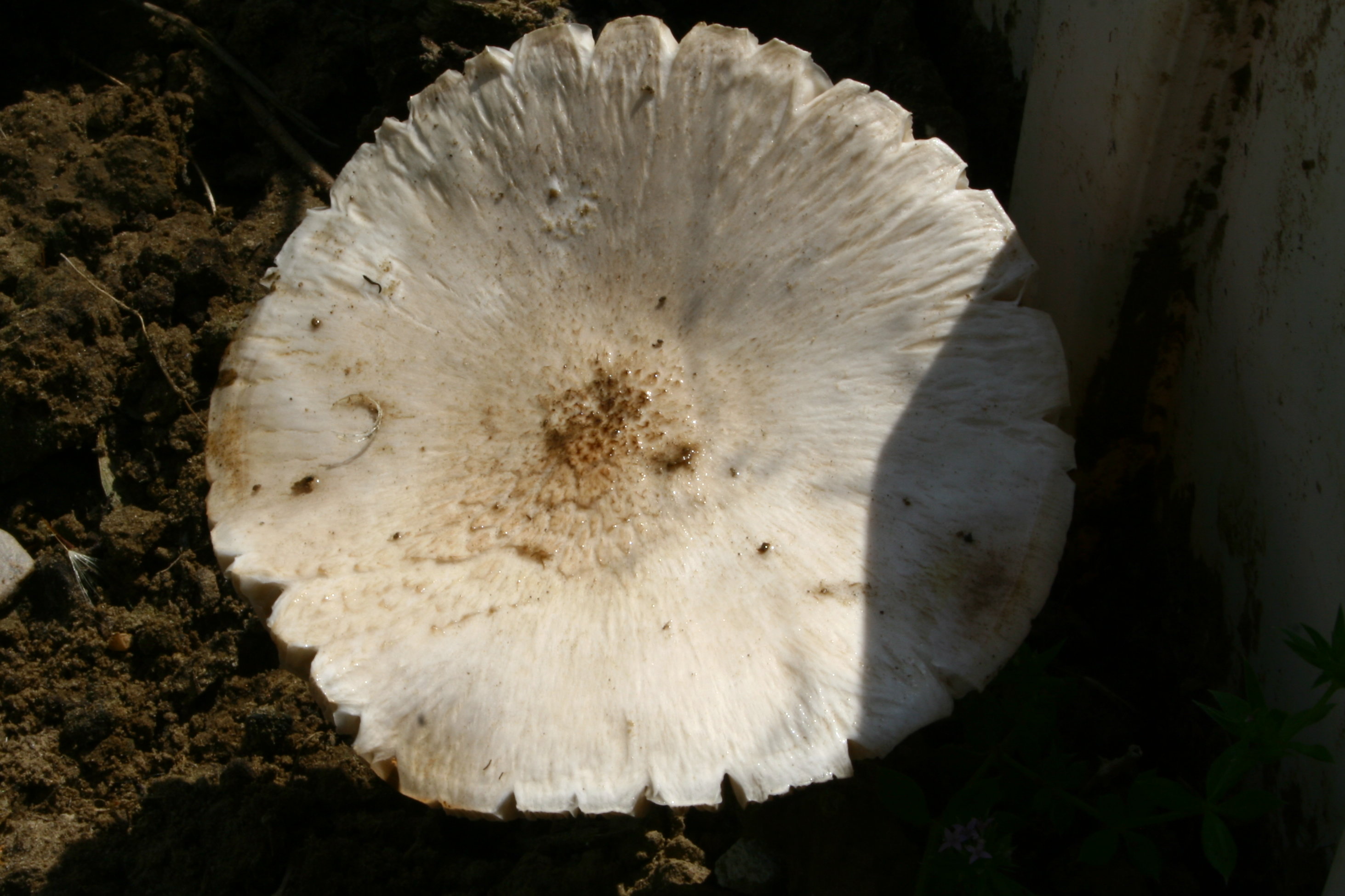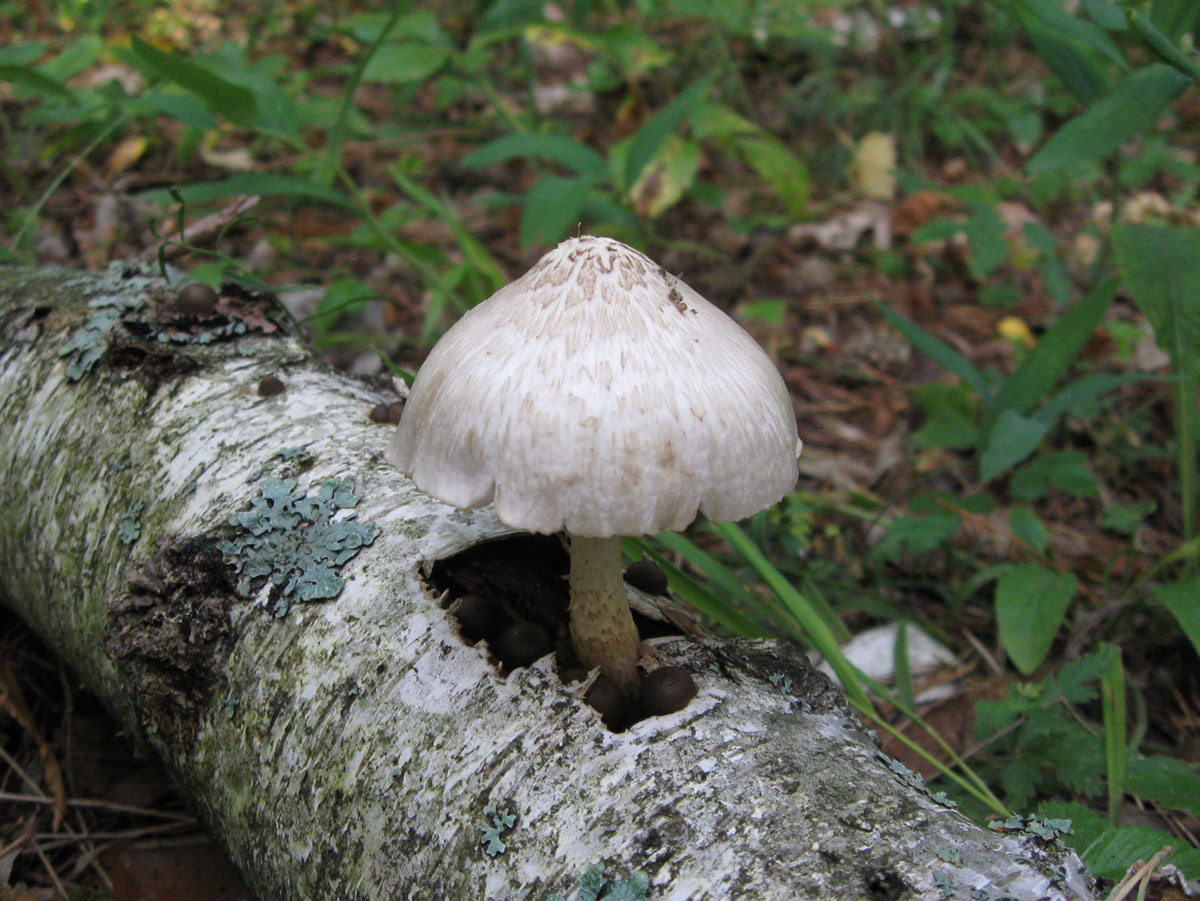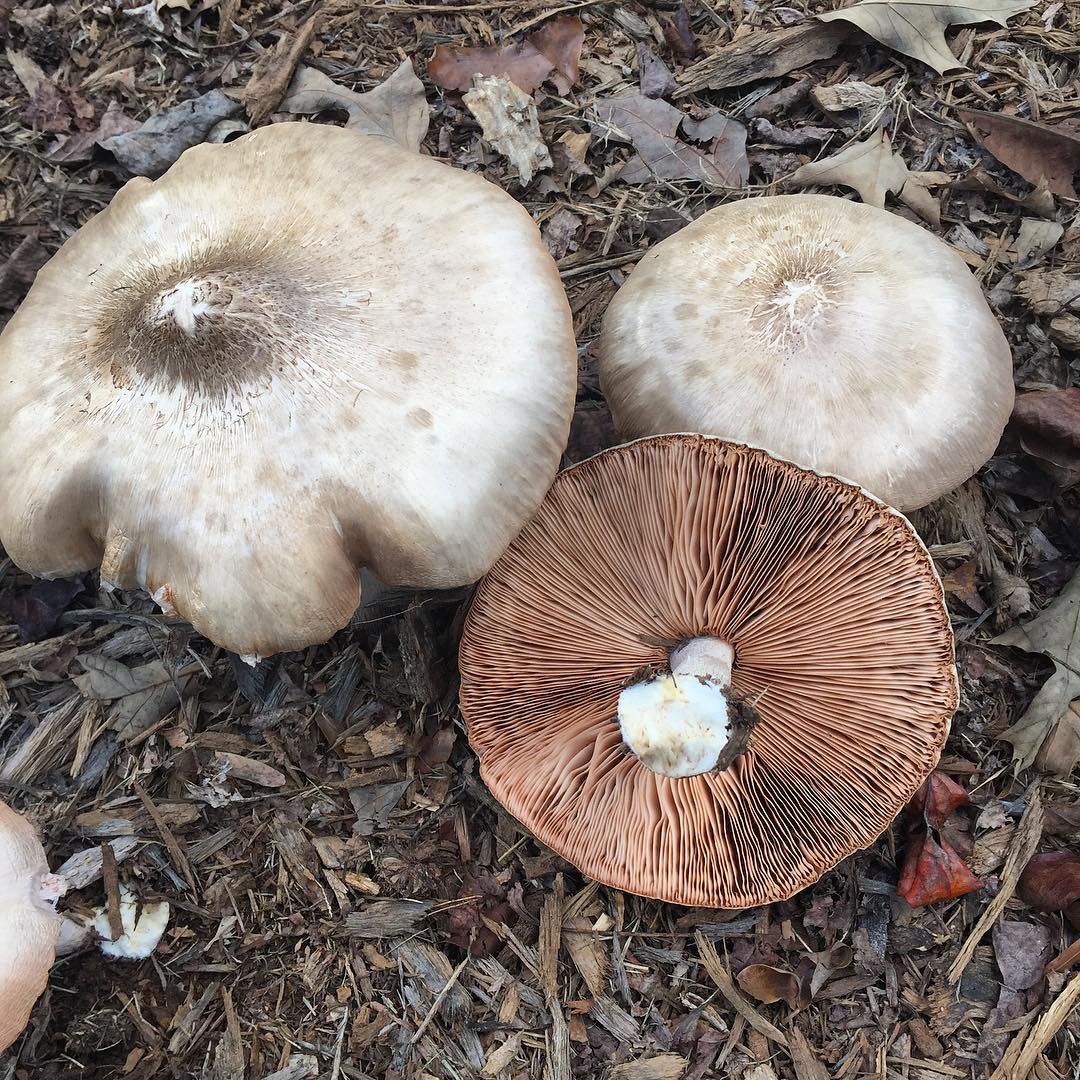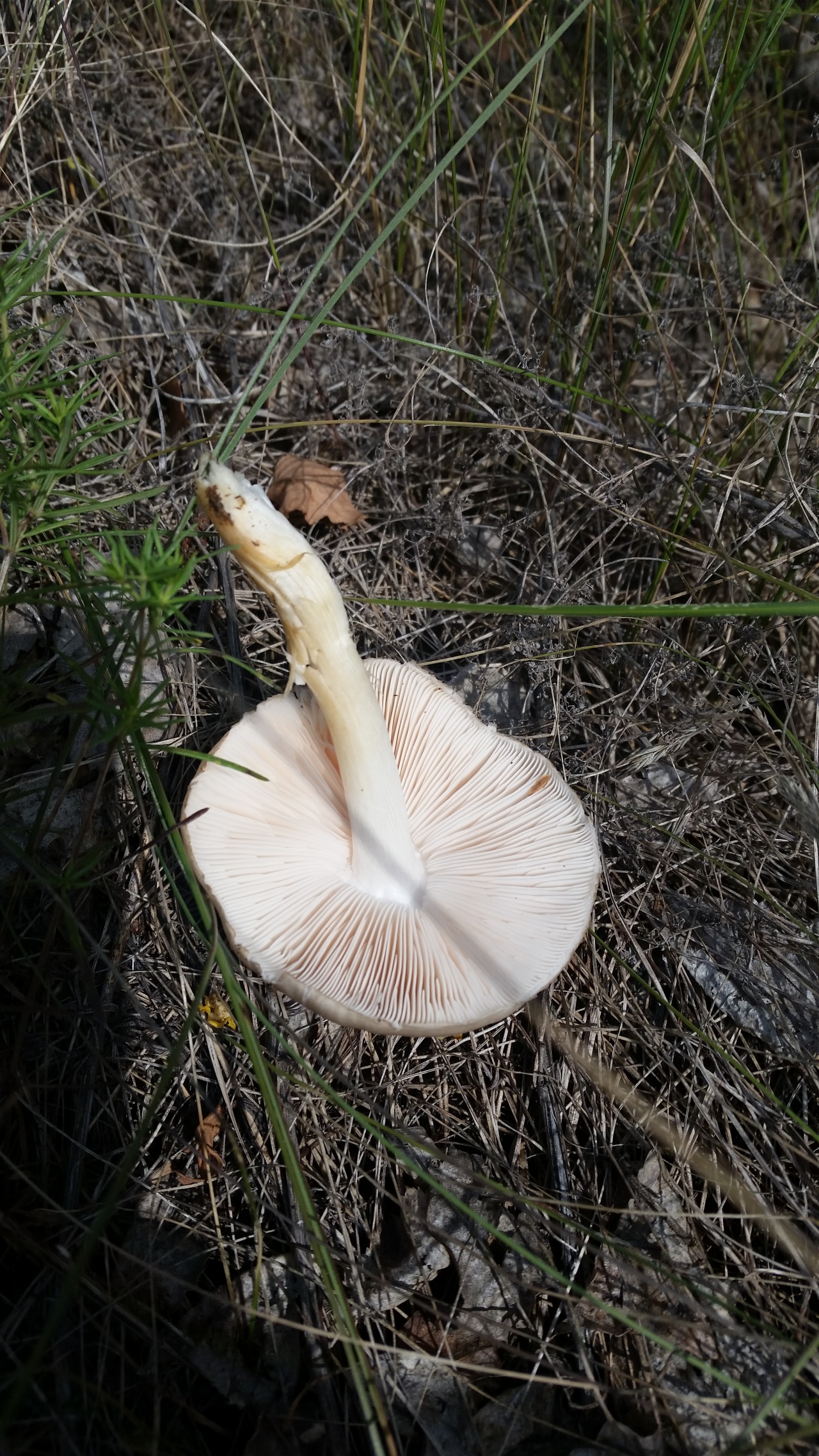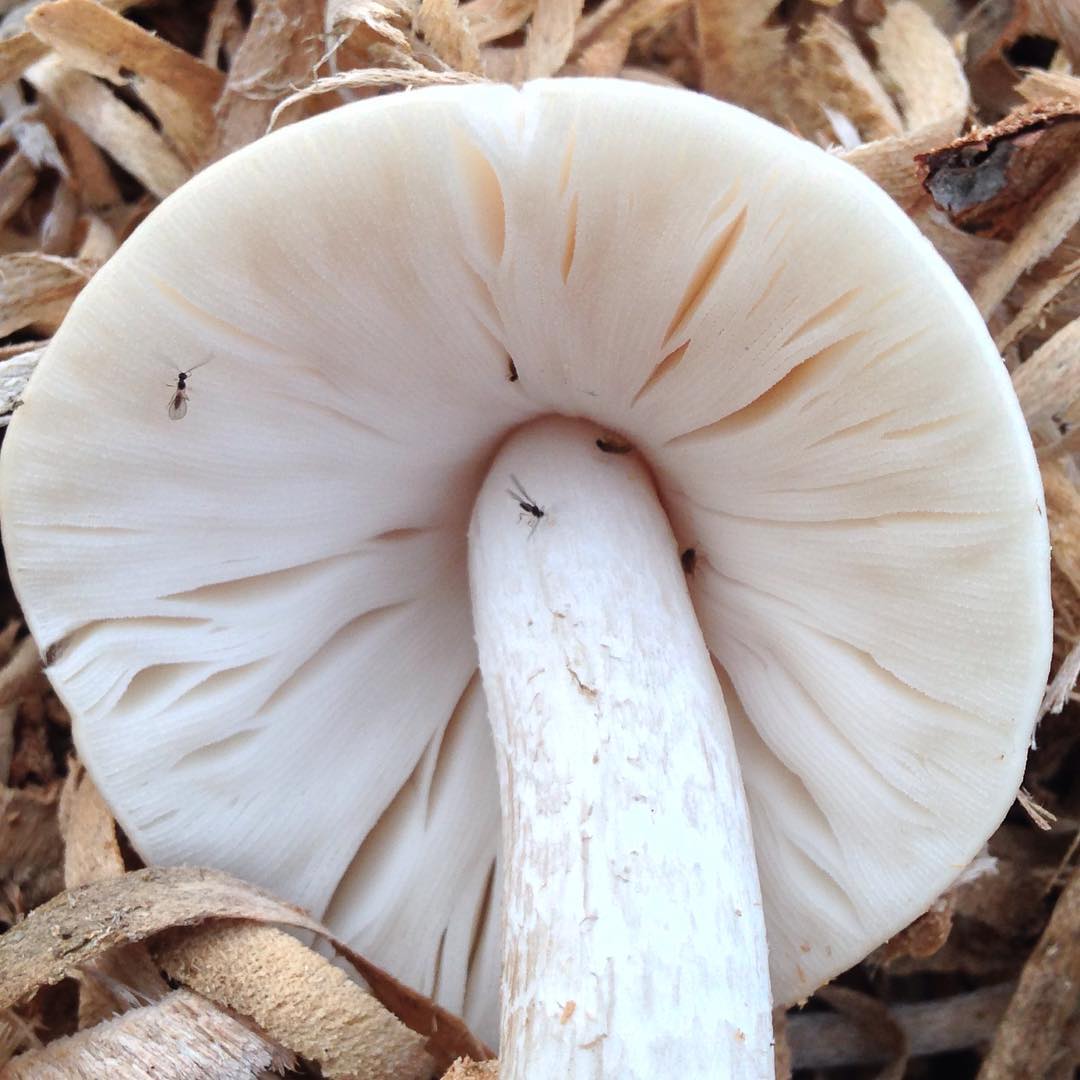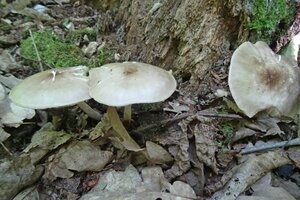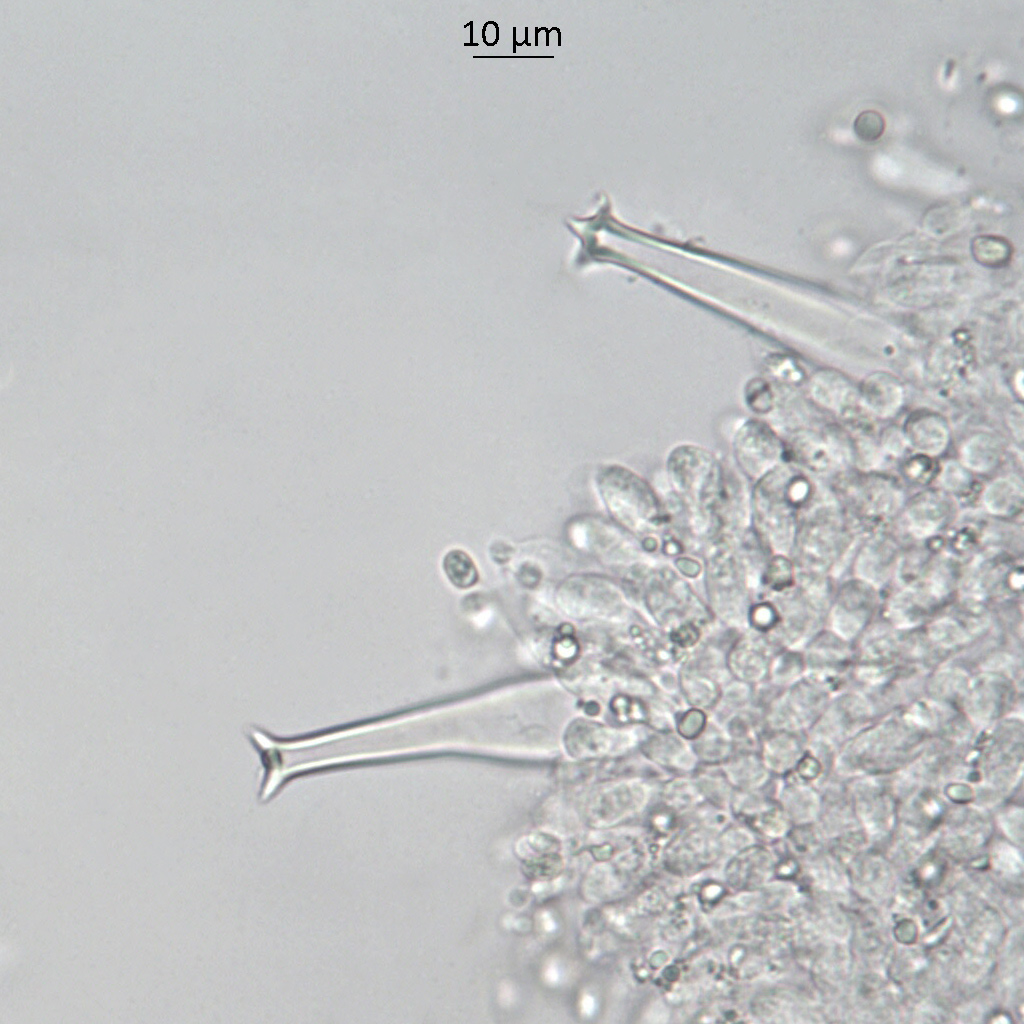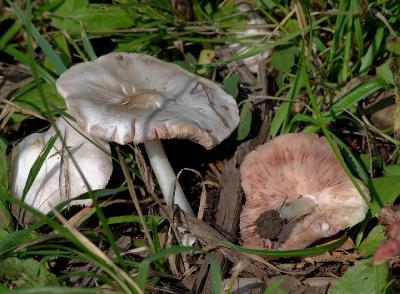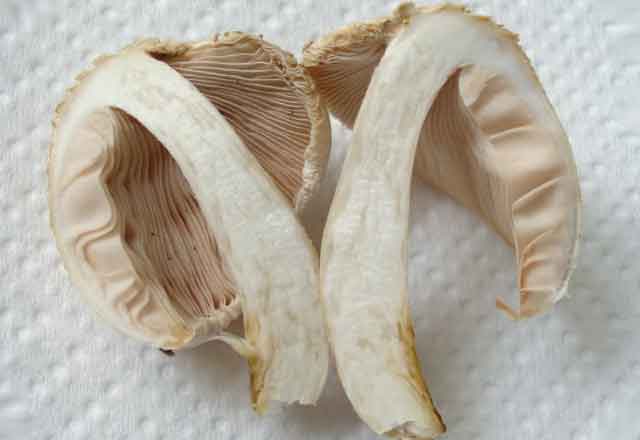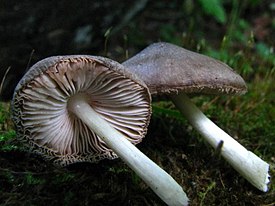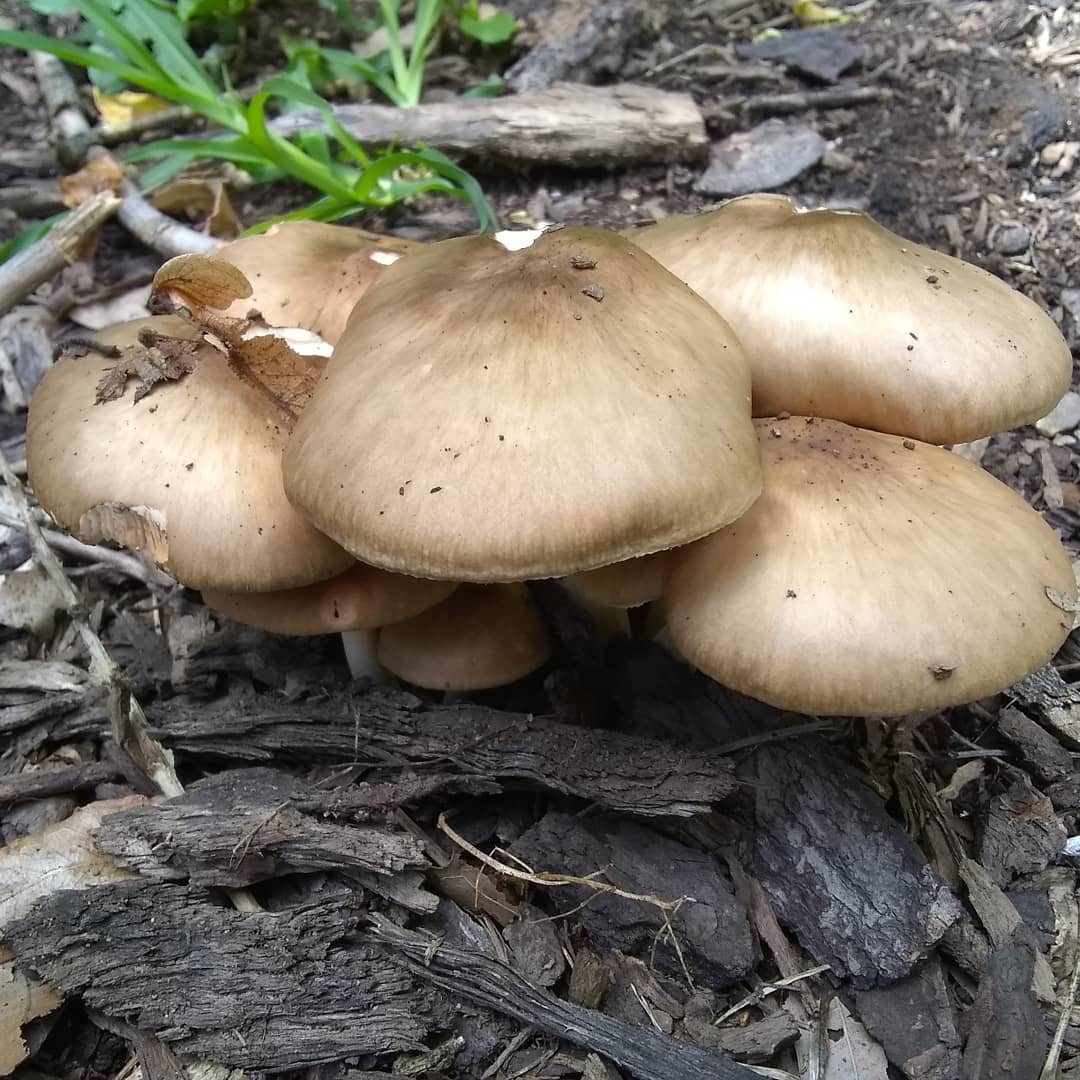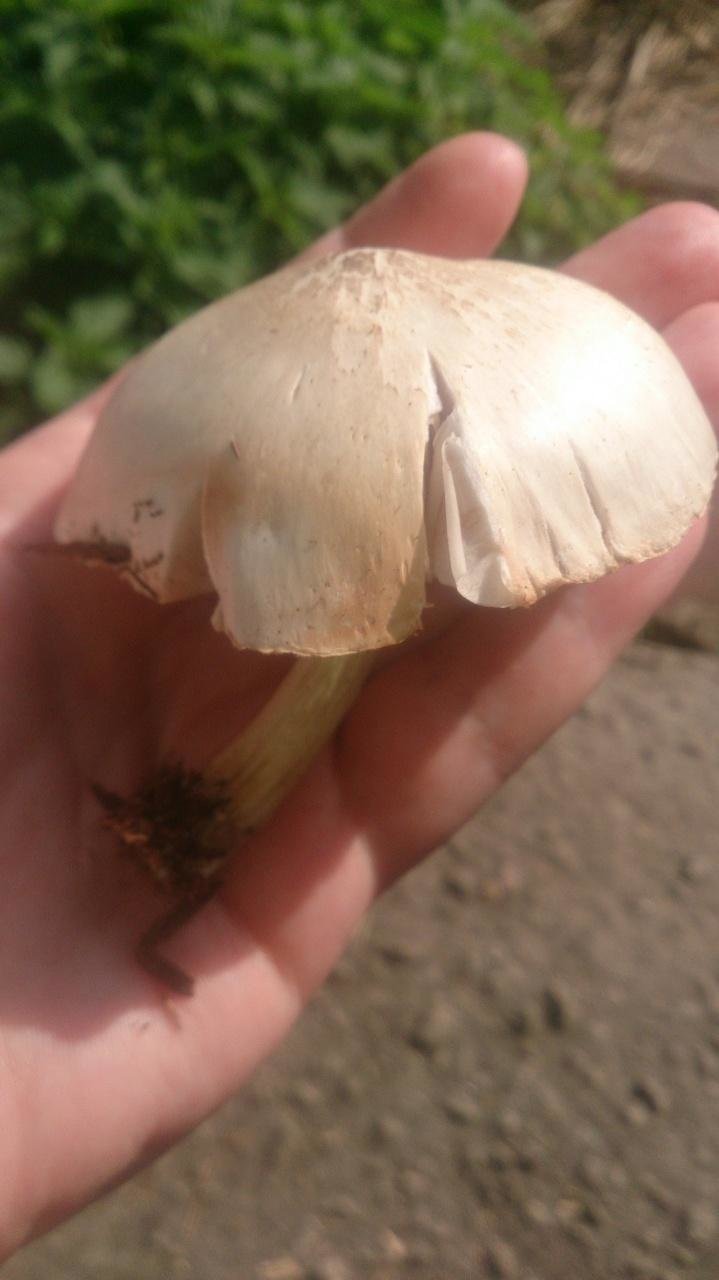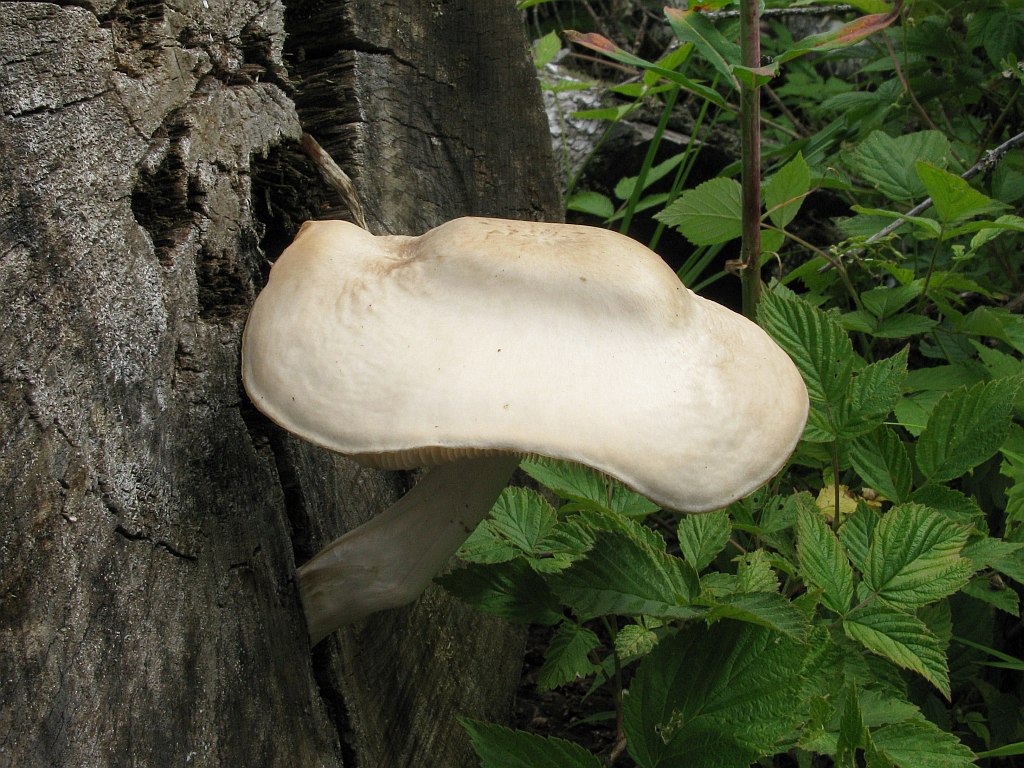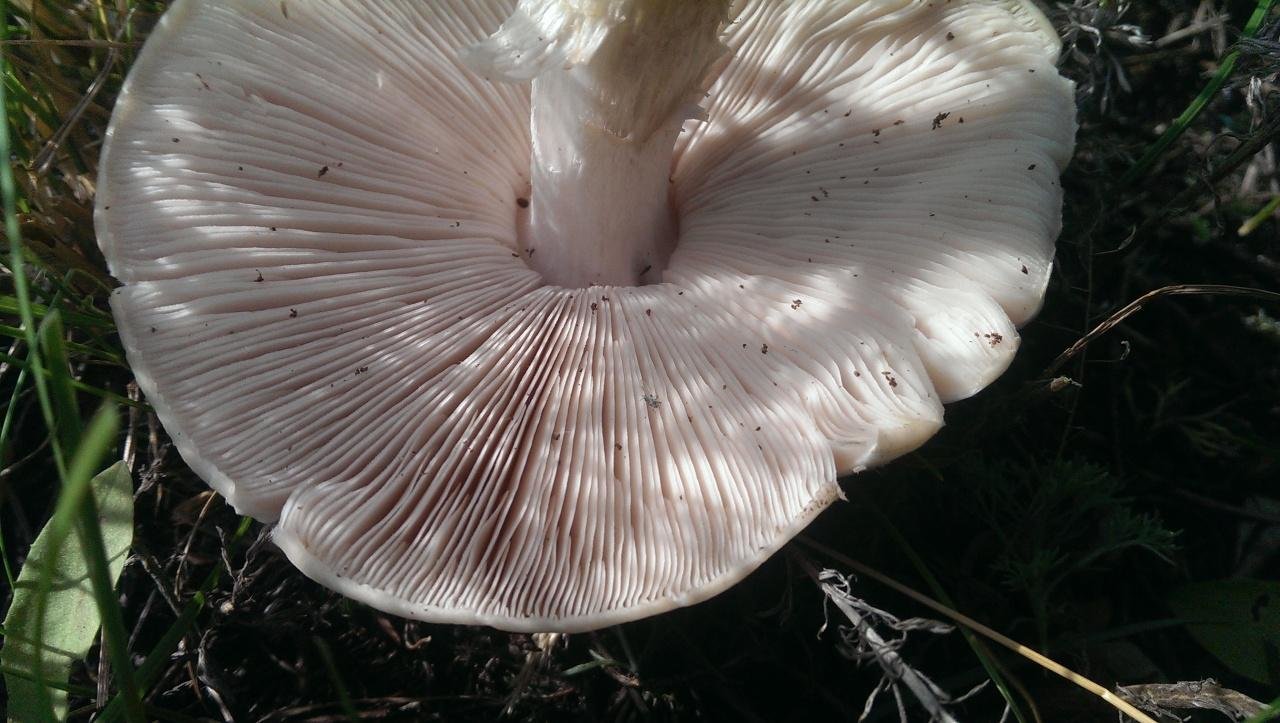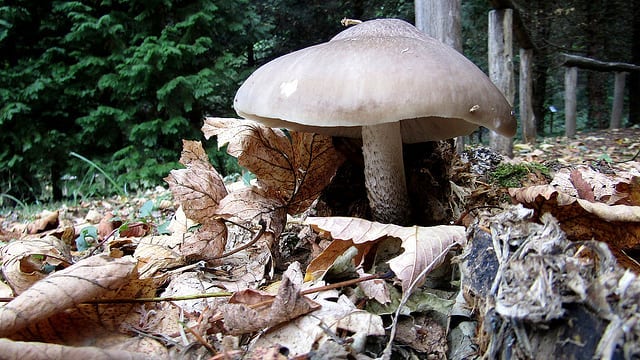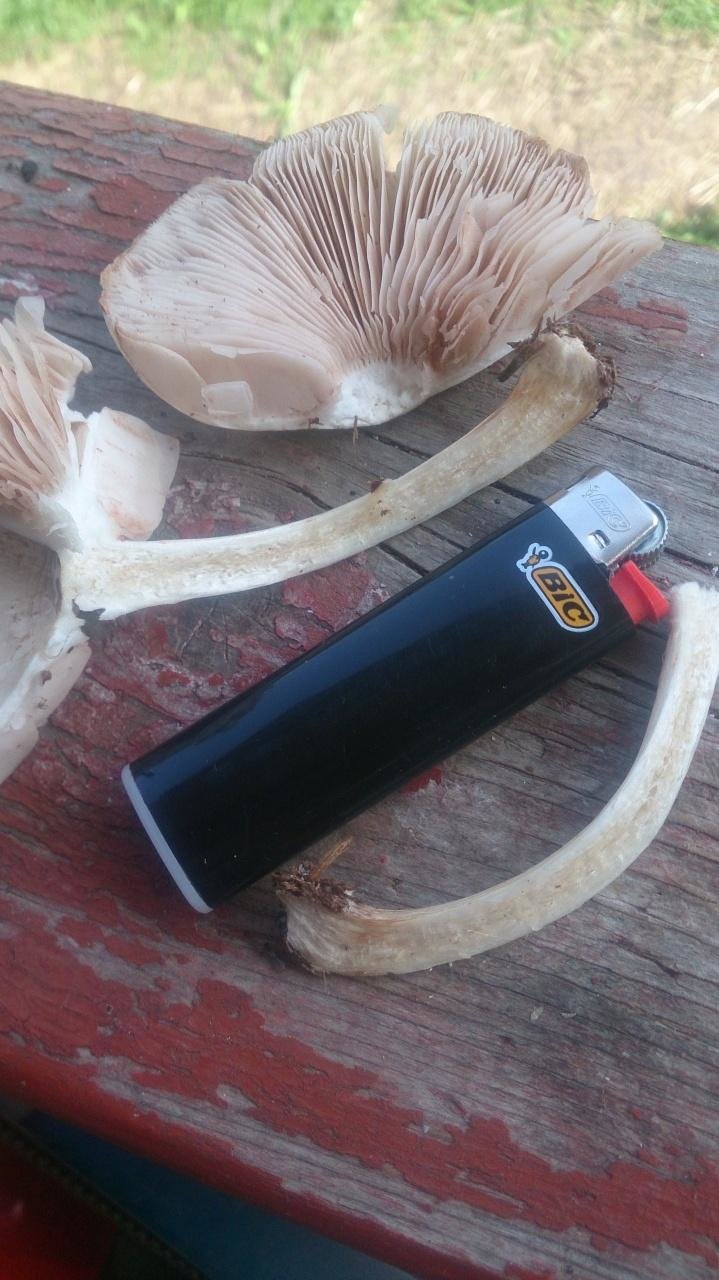Description
The cap is thick-fleshed, 4-15 centimeters in diameter, from convex to flat-outstretched, with a weakly pronounced tubercle or depression in the center. The edge is even, often turned up. The surface is white or grayish-white, darker to ocher-yellow in the center, silky, shiny, dry, sometimes slightly slimy, covered with dark fibers, in the center there are rare small appressed brown scales.
loose, wide, frequent, with plates, from pale pink to pink.
Leg 5-12 x 0.5-1.5 (2) cm, cylindrical, central, even, dense, white, dry. The base is widened, with a brownish fibrous coating.
The pulp is white, cotton-like, does not change on the cut, with a sweetish taste and mushroom smell.
The remains of the bedspreads are absent, the spore powder is pink.
Spores are smooth, ellipsoidal or fusiform, 5.5-8 (9) × 4-5.5 µm.
The hyphae of the cap skin without buckles, 5–20 µm wide, consist of colorless or pigmented cells. The integument of the pedicle also consists of hyphae 5–20 µm wide, with buckles; the cells of the hyphae are cylindrical, colorless, brown at the base.
Basidia are four-spore, 20-30 × 6-9 microns in size, thin-walled, clavate, colorless.
Cheilocystids 35–75 × 10–30 µm in size, clavate or fusiform, thin-walled, colorless, are rare. Pleurocystids 45–90 × 10–20 µm, fusiform or bottle-shaped, thick-walled, colorless, with an appendage, which may be poorly expressed, with 1–4 teeth.
American specimens are characterized by spore sizes of 5-7 (8) × 4-5 µm, cheilocystids - 30-70 × 10-20 µm, pleurocystids with a distinct apicular appendage and 2-4 teeth, 40-100 × 8-15 µm.
Description
Deer roach (Pluteus cervinus) belongs to the Pluteaceae family, the Plutey genus, and also has other names, including the deer mushroom, dark-haired roach. In Russia, it is often called a dark fibrous spit or brown spit. By the way, one of the variants of the origin of the name "deer" is a special color of this representative of the mushroom kingdom, which resembles the color of the wool of a noble animal.
Reindeer roach is an edible lamellar mushroom, but some sources claim that it should not be eaten. However, without explaining the reasons.
Interestingly, the deer mushroom has several variations in appearance.
- the cap is rather large, from 4 to 15 cm in diameter (but there are specimens up to 24 cm), it can have a different shape. It is simply convex (broadly bell-shaped), convex with a tubercle in the middle, and also prostrate. The skin is smooth to the touch, becomes slimy in the rain. Surface with longitudinal fibers, felt in the center. The color changes from gray-brown to dark chocolate; during a drought, the cap can fade. It is darker in the middle than at the edges;
- the leg is moderately thin, up to 15 cm long, up to 2 cm in diameter, has the shape of a cylinder. Dense, thickens at the base, easily breaks off the cap. Sometimes it is very curved (it depends on where the stick grows). The color is white, grayish, on a light background there are dark fibers, sometimes a mesh pattern is clearly visible;
- the flesh is white, does not change color at the break, thick, tough, but brittle. The fibers are clearly visible in the stem. Has a rancid odor. There is no taste as such;
- the plates are loose, thick, wide, fairly frequent, white-pink in young spitters, pinkish-brown in old ones;
- spores are smooth, pink, ellipsoidal.
How to cook reindeer sticks. Places of distribution and description of the noble spit
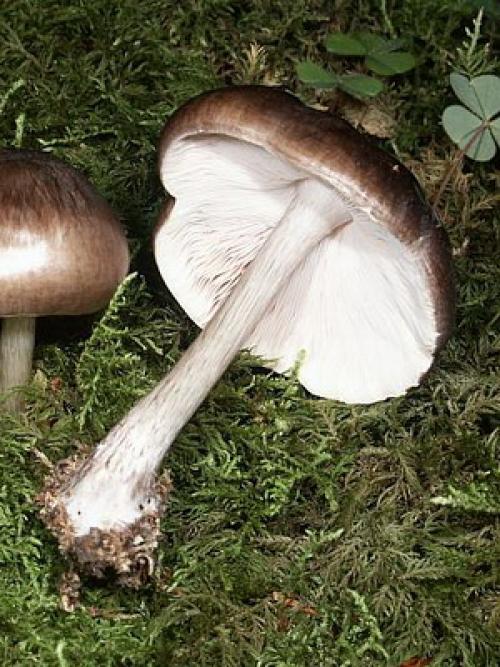
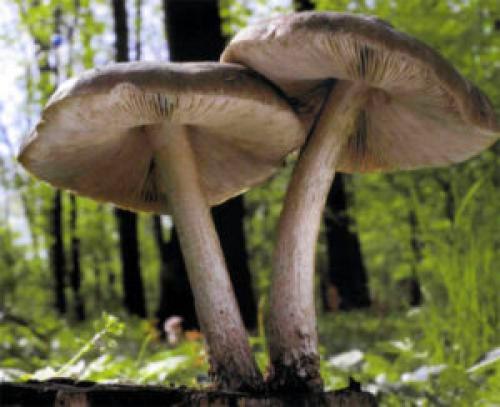
What does the noble cricket look like, in what natural zones it is found, can it be used for culinary purposes? This mushroom is a very controversial representative of its family: the noble clown is widespread over vast areas of the North American and Eurasian continents, but it can be found extremely rarely, recognized as inedible by some sources , it is revered by some gourmets for its delicate and peculiar, according to their statements, taste. What does this mushroom look like and where does it live?
- 1 Description
- 2 Distribution and period of fruiting
- 3 Edible
Description
Pluteus noble (Pluteus petasatus), otherwise domestic plute, is a conditionally edible mushroom from the Plutey genus.Its appearance can be described as follows:
- the cap is quite dense, fleshy, with a diameter of 4 to 15 cm, white, grayish or pale brown, with a dry, shiny cuticle; in damp weather conditions the surface becomes sticky. Convex in young specimens eventually becomes flat-spread, retaining even turned edges and a small dark scaly tubercle in the center of young fruit bodies, which later turns into a depression;
- the pulp of a wadded texture, with a mushroom aroma and sweetish taste, white, does not change on the cut;
- the plates are often spaced, loose, light pink or pink in color;
- spores are smooth, spindle-shaped, their powder is pink;
- the leg is cylindrical in shape with a diameter of 5 to 15 mm, a height of 5 to 10 cm, dense, white, at the base with a slight swelling, covered with a fibrous light brown coating.
Sometimes the mushroom is confused with the edible deer spit (Pluteus cervinus) in which the cap is darker in color and has longitudinal fibers. Dark fibers are visible on the stem.
Distribution and fruiting period
The main distribution area of the noble spit is North America and Eurasia, from the temperate northern to the Far Eastern natural zones.
In Russia, the mushroom can be found on the territory of the Leningrad, Rostov regions and the Krasnodar Territory, in the Volga region, Eastern Siberia and Primorye.
Being saprotrophic mushrooms, noble spitters choose the remains of deciduous wood as a substrate - stumps of poplars, oaks, beeches, preferring moist shady areas of the soil. You can see them under living trees of these species in the lowland and alpine forests.
Mushrooms grow both as individual specimens and in small families. They appear at the end of May and bear fruit until mid-autumn. Fruiting takes place in two waves: in the lowland zones in June, in the highlands in July-August, then in September-October.
Edibility
In addition to the low calorie content, a large amount of protein in its composition, the noble pile is distinguished by a high content of lecithin, which can reduce harmful cholesterol in the body.
This is the main benefit of eating these mushrooms.
Nutritional qualities - an unusual, slightly sweet taste, pronounced mushroom aroma - allow them to be used for preparing a variety of hot dishes: soups, roasts, casseroles.
Plyutei noble is not often seen in the forests, of which it is considered a typical inhabitant. The more interesting it will be for mushroom pickers to meet him, in order to be able to appreciate the qualities of this rare mushroom.
Reindeer ropes: photo and description
Category: inedible.
Reindeer spit hat (Pluteus cervinus) (diameter 4-25 cm): gray, brown or almost black. The edges are usually much lighter than the center, but if the weather is dry and sultry for a long time, it also fades a lot. In young mushrooms, the cap has the shape of a bell, which over time changes to almost completely outstretched with a small tubercle in the center. Silky to the touch, sometimes it can crack.
Leg (height 4-17 cm): usually white or gray, solid, cylindrical, with longitudinal fibers, often with a small reticular or moire pattern. May be severely curved and swollen. Easily detaches from the cap.
Flesh: very brittle, white in color, which does not change at the cut or when exposed to air.
Plates: wide and thick. Young reindeer spitters are white, with time the color changes to pinkish.
The reindeer plyutey got its name from the color of the hat. Has a pungent and tart radish odor.
Twins: the related spines of Posoir (Pluteus pouzarianus) and dark-edge (Pluteus atromarginatus), as well as wide-lamellar colibia (Megacollybia platyphylla). But Pozuar's creeper does not have a distinct smell and grows on soft deciduous trees, the dark-edged crimson is darker and most often found in coniferous forests, and the colibia is distinguished by a creamy shade of the plates.
When it grows: from the beginning of June to the end of August in almost all European countries.
Where to find it: On rotted wood of all types of forests, as well as sawdust. Prefers pine and birch.
Eating: not consumed.
Application in traditional medicine: not applicable.
Other names: brown plyutey, dark fibrous plyutey.
Reindeer roaches and mushrooms similar to it
The mushroom is edible. The reindeer mushroom got its name thanks to the love of reindeer for this subspecies. It is these animals that eagerly eat them. Like all Spiney ones, they love places with putrid woody soil. They can be found even in vegetable gardens, if before that work was carried out to fertilize the soil with sawdust.
Subspecies from the same family are considered similar mushrooms with deer spitting:
- brown;
- fibrous dark.
It grows one or several pieces on stumps, on the trunks of fallen trees, but you can collect a lot of it.
Look at the deer in the photo. Description of its main external features:
- The plates are located freely from each other, high, at first whitish, then pink.
- Part up to 12 cm, brittle, thinly fleshy. Initially, it is bell-shaped, then open, with a low blunt tubercle, silky, fibrous, gray or gray-brown.
- The pulp is white, soft, does not change color on the cut, with a slight odor. Spore powder pink.
- Leg up to 12 cm long, up to 2 cm thick, filled with pulp with fibers, grayish, sometimes with dark strokes. The ring and Volvo are not detected.
Fruiting from May to November.
There are no poisonous mushrooms similar to rookies.
After boiling for 5-15 minutes, the rare smell of pulp disappears, and the mushroom is suitable for further culinary processing. It is salted and pickled. It is better to use reindeer sticks mixed with other mushrooms.
Look at the deer in the photo:
These mushrooms are not harmful. Their striking appearance makes it impossible to confuse this species with other inedible ones. The mushroom has no inedible analogues.
Description of the mushroom mushroom.
Plutey is the general name for a whole genus of mushrooms, among which there are not only edible, but also hallucinogenic and poisonous. This genus is included in the Pluteev family, contains many varieties, the number of which is still not known exactly. Of the studied varieties, science knows only 50, but according to unofficial data, there are much more species - up to 300. Translated from Latin, the name of this genus means "shield".
The fungus is not a parasite, on the contrary, in nature it performs the most important function - it is responsible for clearing the forest. Plutey provokes the process of decomposition of dead wood, therefore it is rightfully considered a "forest orderly". Consider the external characteristics of edible varieties that are often found in forests.
- Willow rogue.
A common mushroom, found almost all over the world, except Australia. The most common mushroom in Eurasia, less common in Africa and North America. The willow roach is an edible variety that belongs to the third category.
The hat can grow up to 9 cm in diameter, is painted in unusual colors - it can be ashy, pinkish or gray-blue. The youngest mushrooms have a bell-shaped cap. In old mushrooms, the caps become flat, open, a network of wrinkles appears on their surface, and the edges become slightly darker.
Low, cylindrical stem in young mushrooms, starting at 3 cm in height. In mature mushrooms, the height of the leg is not more than 13 cm, and the diameter is up to 2.5-3 cm. The leg is tapering, fibrous, painted in a white or bluish tint. The plates are narrow and frequent, not adherent to the stem, from white to pinkish-cream shade.
- White rogue.
This variety is used for frying and drying and has good taste. White plyuti is widespread in oak forests and poplar plantations. The diameter of the mushroom cap is from 4 to 10 cm, from bell-shaped to open-ended, painted in a light yellow, white or lemon shade.
The plates are pale yellow or white, rare, can acquire a pinkish tint in mature mushrooms. The leg is up to 8-9 cm in height, closer to the cap it is narrower and wider at the base, dense and fibrous. The pulp is odorless and tasteless, pale yellow or white, does not change its color during oxidation.
- Reindeer rookies.
This species is the most numerous in the forests of Russia. Deer mushroom, or deer mushroom, is an edible mushroom that grows, like other species, among rotten wood. The cap of a deer mushroom is up to 9 cm in diameter, has the shape of a wide bell, and becomes flat-spread with age. The skin of the cap is colored gray-brown, it can be chocolate and even black.
The plates of the deer mushroom are white, wide and frequent; with age, they can acquire a slightly pinkish or gray-pinkish tint. The pulp is characterized by the absence of taste and aroma, in the place of the cut is white or yellowish, practically does not change the shade. Mushroom leg up to 2 cm in diameter and up to 15 cm tall, gray-white or white.
There are several other varieties that are conditionally edible, but picking and eating them is considered risky. Conditionally edible varieties are suitable for consumption only after thorough soaking and prolonged cooking, but even so, their use can provoke problems with the digestive tract.
How to lose 7 kg in a week. During the week

Many people consider it normal to lose 1 kg daily. Based on this simple arithmetic, losing 7 kg in a week is a great option. In fact, nutritionists warn: safe weight loss is to lose 1 kilogram in 7 days. Everything else they call a mockery of the body.
And nevertheless, there are situations when it is simply necessary. We develop an action plan on how to put the figure in order in such a short time.
Diet "Minus 7 kg in 7 days"
Diets will no longer be as strict as five-day diets, but you still have to tighten the belt: you will not go anywhere from hunger. What can you choose?
Limits daily calories to 1,000 kcal. The main rule of product selection is a minimum of carbohydrates and fats. The basis of the diet is protein foods and vegetables. Recommended for athletes and men.
Suitable only for those who love this grain. Buckwheat needs to be steamed according to a special recipe in the evening, and then eat a limited amount over the next day. Additional products include boiled chicken breast, 1.5% kefir and green apples. It is difficult to transfer. However, it is quite possible to lose 7 kg in 7 days, and with the preservation of muscle mass due to protein.
An interesting diet that limits any serving to 5 tablespoons (approx. 150 g). You cannot eat a larger amount at a time. Fully complies with the principles of fractional nutrition. The plus is that you can eat almost everything. Restrictions apply only to alcohol (complete ban), sugar and salt (minimum).
Sport
To surely lose weight on your cherished 7 kg, back up your chosen diet with workouts. A rough plan might be as follows:
- Monday, Wednesday, Friday - cardio training, fitness, dancing;
- Tuesday, Thursday, Saturday - cycling / pool / horse riding;
- daily - exercises and jogging in the morning, hula hoop in the afternoon, walking at a high pace in the evening.
Of the additional activities, you can advise the same ones that are prescribed for 5 days.
Edibility and hallucinogenicity of blue-footed spit
It is believed that after pre-boiling, blue-footed plutes are edible. When boiled in water at a temperature of 150 degrees, psilocybin turns into psilocin, and if boiling for a long time, then these toxic components are destroyed and the mushrooms become edible. And upon drying, about 50% of the activity of the psilocybin components remains.
These mushrooms contain psilocin, psilocybin and beocystin. They are considered moderately or weakly active. The concentration of psychoactive substances varies greatly depending on the place of growth.According to research, the bluefoot plutney contains 0-0.02% psilocin, 0.05-0.25% psilocybin and 0-0.008% beocystin.
Physical dependence after the use of blue-legged spit does not develop, but with their regular use, mental craving arises. The action of these mushrooms causes a hallucinogenic effect, a person hears sounds in the head, sees visions, loses the sense of time. It may seem to him that he is watching his body from the side. Eating psilocybin mushrooms can lead to feelings of euphoria and unbridled joy, but large doses can cause feelings of panic and dangerous behavior.
According to research conducted in the UK, psilocybin mushrooms are considered the least dangerous recreational drug. Some studies have noted the "striking non-toxicity" of psilocybin. But in any case, it is a drug, the use of which causes inappropriate behavior, possibly dangerous behavior and health problems.
Similar species
Another psychoactive willow mushroom is close to the blue-legged spitting. But the blue-footed rogue can be distinguished by its smaller size, the wrinkled center of the cap, the uniform color of the plates and the inexpressive taste and smell.
The fruit bodies of willow spitters also contain psilocybin. The diameter of the cap reaches 7 centimeters, the shape of the cap changes over time from bell-shaped to flat-spread. The cap is thick-fleshed, while the edges are thin. The surface is fibrous-wrinkled, shiny. The color is grayish or ash-gray with a bluish or pink-brown tinge. The leg height is 12 centimeters. The color of the leg is bluish with a gray-olive tint.
Willow spits grow on willow, beech, poplar, alder and oak wood. These mushrooms are common in Eurasia, North America and North Africa. They are rare. Listed in the Red Book of the Leningrad Region.

